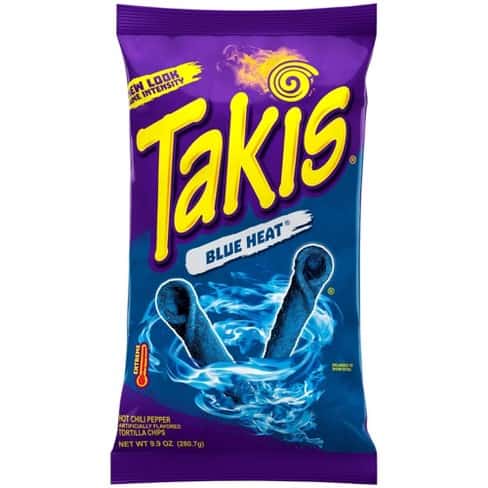Takis is a type of rolled corn spicy tortilla chip. Several differences can be noted when comparing red and blue Takis. The most significant difference is in the flavor.

Difference Between Blue and Red Takis
Red Tasti has a sweet and spicy chili taste, while blue Tasti has a more sour lime flavor. Additionally, red Tasti have a higher heat index than blue Tasti, making them spicier to eat. In terms of nutrition facts, the two flavors are pretty similar. Both are fried corn tortilla chips with added seasonings for flavoring and color. Each one-ounce serving contains 140 calories and 7 grams of fat. They have wheat flour, soybean oil, sugar, salt, and artificial coloring agents.
The visual appearance of both red and blue Takis is also distinct. Red Takis features a bold combination of yellow-orange powder coating with red specks. Blue Takis, conversely, features an electric blue powder coating that is almost glowing when held close to the light.
Texture-wise, both types of chips follow the same crunchy pattern, but their unique flavors make each one stand out in its own right when trying them side by side. Red Takis are known for having a powerful kick at first bite, while blue ones have a sweeter start that builds into a subtle tanginess as you finish off your chip haul from the bag or box.
Are blue or red Takis hotter?
Red Tais are hotter because they have a higher heat index than blue Tais. In my personal opinion, the difference is not huge, but Red Tais have a more robust and hotter taste.
Are blue or red Takis hotter? This is a highly debated topic among snack and spice lovers, and trying to settle the score once and for all can be difficult. However, some critical facts about these two tasty treats could help us determine which is spicier.
First and foremost, let’s look at the ingredients in each flavor of Takis. Blue and red have the same base ingredients of corn masa flour, vegetable oil, salt, and several seasonings. The main difference between the two flavors is how much chili powder they contain: the blue flavor has more chili powder than the red flavor. This means that the blue flavor will generally be spicier than the red.
However, it’s important to note that individual batches of Takis can vary significantly in their spiciness, even when looking at just one type of flavor. This is due to various factors, such as ingredient changes or production methods over time. The best way to determine a definite answer to this question would be to taste both flavors side by side – perhaps you have a friend or family member who has both flavors on hand!
In addition to their chili content, the shape is another factor to consider when looking at which Takis are hotter. Blue Takis typically come in a great ring shape. In contrast, red Takis usually go in thinner rolls or sticks – so depending on your preference for different textures or shapes when eating snacks, you may prefer one form over another regardless of their respective heat levels.
Since blue Takies contain slightly more chili powder than Red ones do on average, it stands to reason that they would be considered “hotter” than Red Takies overall—although, as previously mentioned, this could vary depending on individual batches and tastes. So, if you’re looking for something with more kick than regular chips and snacks, grab those blue-flavored ones!
Conclusion
Overall, red and blue Takis offer different flavor experiences that depend on individual preferences. However, both provide excitement regarding snacking with their unique seasoning blends, distinct visual appeal, and texture nuances when tasted side by side or independently.




